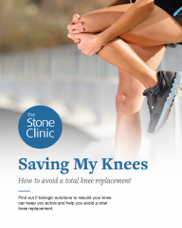Knee Swelling Q & A

Doc, I injured my knee and heard a pop. My knee swelled. What’s up?
If you have injured your knee by twisting it on the soccer pitch or while playing tennis and heard a pop, there is a 90% chance you have torn a critical structure inside your knee. This is most commonly the meniscus, articular cartilage, or ligaments. Such injuries cause swelling, which means that the tissue is torn enough to cause bleeding into the joint and irritate the lining. In the 21st century, each of these tissues can be repaired or replaced. Most important is that if you have torn your meniscus tissue, it should be saved as much as possible since we know that loss of meniscus tissue directly relates to the development of knee joint arthritis. Replacement of the meniscus if necessary can save the knee. Early surgical regenerative treatment is the key.
Doc, I was kneeling while fixing my roof and my knee swelled. What’s up?
Patellar tendonitis (or patella bursitis) has many names. These include Housemaids’ Knee, Nun’s Knee, Carpet-layer’s Knee, and Coal Miner’s Knee. All are caused by irritation of the thin bursa that overlies the patellar tendon—which causes this normally thin layer to swell into a ball filled with thickened synovial tissue and inflammatory fluid. The treatment starts with compression, ice, and massage to break up the scarring. Unfortunately, needle drainage and injections of cortisone have too often led to infection of the bursae. Active rest with circular protection of the bursa (using a donut-shaped soft knee brace) and exercising the rest of the body work to heal this condition over time. The role of PRP or anabolic injections in bursitis is under evaluation and may be helpful.
Doc, my joints ache and my knee swells. What’s up?
Arthritis comes in several forms. Traumatic arthritis is the result of injuries to the articular cartilage surface, the meniscus, and the ligaments of the knee. The trauma and instability lead to abnormal force transfer and wear. Osteoarthritis is a disease that may be primarily genetic in origin (though there is a real likelihood that your microbiome in your gut and your environment may play a role. “My mother and father had arthritis"…yes, but you grew up in that infectious agent environment too). Arthritis leads to deformity of the underlying bone, irritation of the synovium, and loss of the articular cartilage load-bearing surfaces. Injections for arthritis with bone marrow cells, platelet-rich plasma, and other agents are growing in popularity as it works sometimes incredibly well…just not reliably yet.) Infectious arthritis is recognized by damage of the bearing surfaces and inflammation of the joint with destruction of the underlying bone—often with cyst formation from infectious agents including bacteria and viruses.
All of these three arthritic diseases can cause primary joint swelling, as the cells of the synovium (the lining of the joint) respond to irritation with fluid production. In traumatic and osteoarthritis, treatment begins with an accurate diagnosis, followed by either injections, arthroscopic cleaning, or restoration of the tissues followed by partial or joint resurfacing. Infectious arthritis is treated by infectious agent eradication, followed by joint resurfacing.
Doc, my knee is swollen, hot, and hurts. What’s Up?
Bleeding and infection are the two most common causes of a hot, swollen joint. Bleeding from an injury or surgery leads to a hematoma or collection of blood. The body responds by trying to break up the clot; this response produces heat. A hematoma caused by bleeding can be aspirated and withdrawn from the knee. Infection, in contrast, stimulates a multi-system immune reaction, which includes cellular, vascular, and lymphatic responses. This rush of fluid and cells leads to warmth and swelling. Infection is a medical emergency and must be treated with a surgical wash-out and antibiotics.
Doc, my knee swells after I run or hike but is otherwise okay. What’s up?
Joint mechanics are a function of running gait, shoe wear, running surfaces (such as soft trails or hard cement), body alignment (hip, knee, ankle, and foot angles), and a host of muscle strengths and weaknesses. Knee joints can get irritated from the abnormal forces produced by any of these factors. Often, working with a physical therapist and/or fitness trainer can fix the problems.
When your knee talks to you, it is a good idea to listen and actually hear what it is saying. If it’s speaking a foreign language, come see a qualified translator—and convert the cacophony to harmony.


